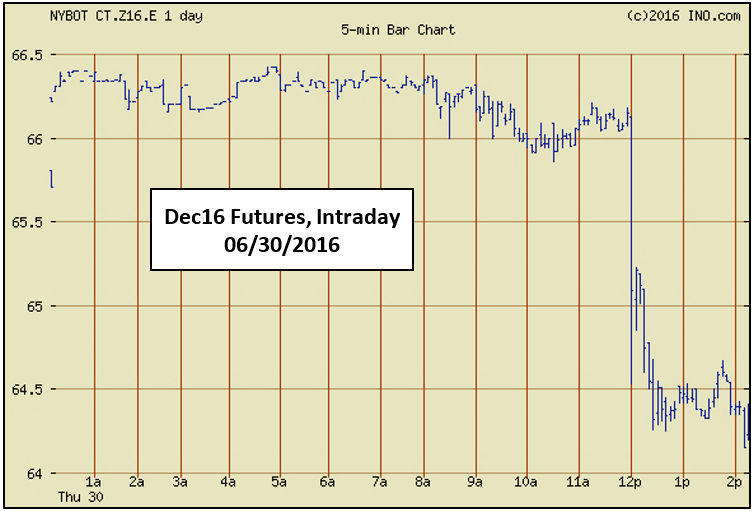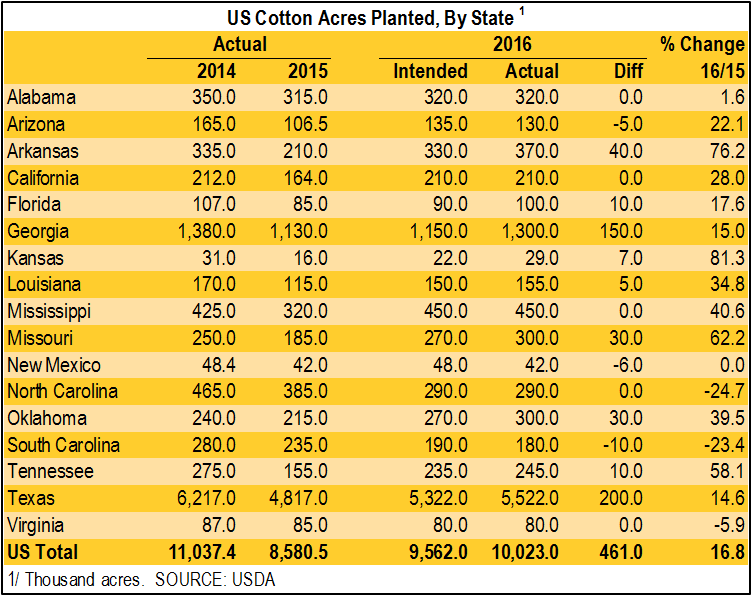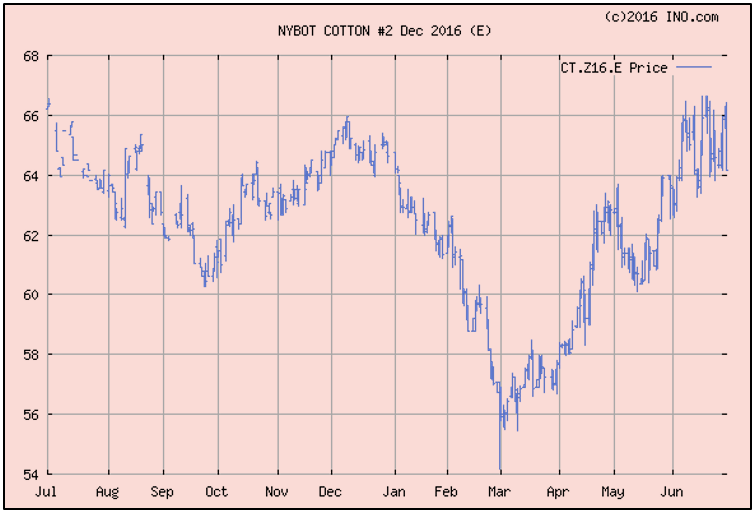 For the entire month of June, cotton prices (Dec16 futures) have been “range-bound” mostly between 64 and 66 cents. In light of today’s planted acreage report, it would have to be considered good news if prices can remain at or above 64 cents.
For the entire month of June, cotton prices (Dec16 futures) have been “range-bound” mostly between 64 and 66 cents. In light of today’s planted acreage report, it would have to be considered good news if prices can remain at or above 64 cents.
Prices (Dec16 futures) were around or above 66 cents most of the morning. After USDA’s annual Acreage report was released at noon, prices immediately dropped triple digits and closed today at 64.17 cents—down 168 points.
In March, farmers said they intended to plant 9.562 million acres of cotton this year. Actual acres planted are estimated at 10.023 million acres—461,000 acres more than earlier intentions and 17% more than last season. An increase from last year (which we knew first from the March numbers) was not unexpected. What’s a bit of a surprise is this increase, or really the magnitude of the increase above the March intentions.
Of the 461K additional acres, 150K comes from Georgia and 200K from Texas—76% accounted for by those 2 states alone. Actual acres planted were higher than intentions in 9 of 17 states. Actual acres planted were less than intentions in only 3 states.
Planting decisions are influenced by many factors including relative prices and net returns, farm program payments and incentives, weather, crop rotations, financing, and risk. Since the earlier March report, cotton prices have improved; but corn and soybean prices have also improved. Although cotton prices have improved, with prices still in the 60’s, a higher price is simply a trade-off for a lower LDP/MLG.
Compared to last season, acreage is expected to decline in only 3 states—North Carolina, South Carolina, and Virginia. County Extension Agents say the decline in acreage is due to crop and financial losses and lingering bad feelings from last season, higher expected net returns from other crops—especially corn and peanuts, lower cost and risk in other crops, and weather delays this season.
 Percentage-wise, big increases in cotton acreage were seen in Arkansas and Missouri where there was a big increase in grain sorghum acreage last year—due to high price and, as I recall, the inability to get cotton and other crops planted on time.
Percentage-wise, big increases in cotton acreage were seen in Arkansas and Missouri where there was a big increase in grain sorghum acreage last year—due to high price and, as I recall, the inability to get cotton and other crops planted on time.
In Georgia, cotton acreage is forecast at 1.3 million acres—150,000 acres higher than March intentions and up 15% from last season. The increase or magnitude of increase is somewhat surprising, as corn is also up (70K acres). Peanuts, soybeans, and grain sorghum are all down (15K, 60K, and 15K respectively).
The 2016 US crop is currently estimated at 14.8 million bales. This is based on the March intended planting of 9.56 million acres, abandonment of 8%, and yield of 807 lbs/acre. The July supply/demand report will be released on July 12th and revised based on the new 10.023 million acres number and updated crop conditions. Expectations are that the US crop could now be in the neighborhood of 15.5 to 16 million bales.
A larger US crop could be bearish for prices, but there are so many other factors in play. Looking ahead to the July report, other factors will include expected production in China, India, Pakistan, and Turkey; projected Chinese imports and mill use; and World use.
For the past month, prices (Dec16 futures) have been erratic but in a range of mostly 64 to 66 cents. Prices are “congested”—often a wide range of prices during the day but still range-bound.
For now, the upper side of the market is still likely to be in the 64 to 66 cent area. Today’s numbers may keep us more on the lower side of that range, however, and pressure prices downward, if other of the factors just mentioned fail to provide more bullish support.
As we move forward, the downside risk in prices is likely the 60-cent area. The upside potential is 66 cents or better.
 _______________
_______________
William Don Shurley, University of Georgia
229-386-3512 / donshur@uga.edu
- Friday Feature:American Agriculture is Losing the Trade War in the Food Commodity Export Market - October 31, 2025
- Friday Feature:Ford Farms Featured on Local News Story about Peanuts - October 24, 2025
- September 2025 Weather Summary and Last Quarter Outlook - October 10, 2025
